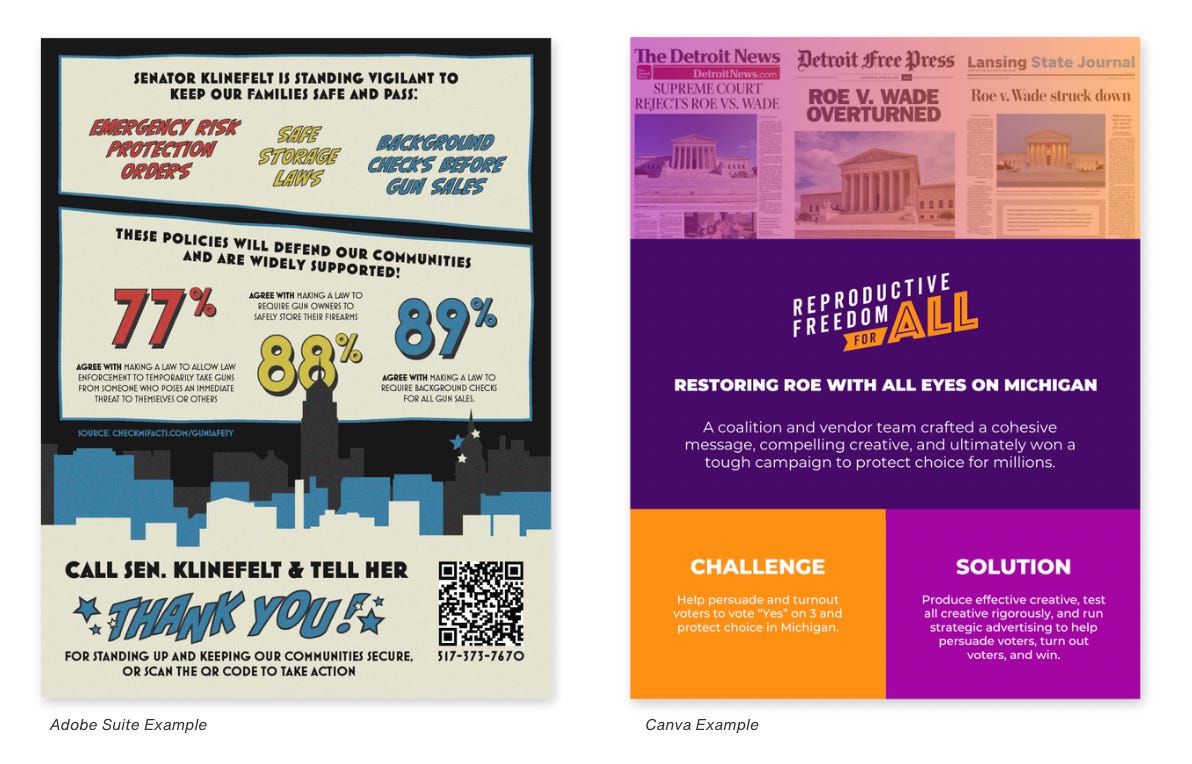Are you ever scrolling through social media then something makes you stop because it's so beautiful and visually unique that you feel like you need to pause and take a second look? Truly great design can do that. Whether you are making elevated designs or are trying to knock out some social media graphics, there are more design tools than ever.
The tools we choose to bring our creative visions to life can make or break the quality and efficiency of our designs. There are two frontrunners in the design world who often go head-to-head; Adobe Creative Suite— with heavy-hitters like Illustrator, Photoshop, and InDesign—and the user-friendly, more accessible Canva. While both platforms have some overlap, each has unique features that cater to different creators.
Overall Similarities:
Visual Content Creation: Both platforms are here to aid in visual content creation, whether it be images, graphics, or publications.
Customization: Each offers tools to tweak designs, allowing users to input their own colors, fonts, and other design elements.
Export Options: Users can export their work in multiple file types that are suitable for web, print, or other media from both formats.
Cloud Features: Both have the option to allow users to save their work in the Cloud.
AI Tools: Each has kept with the times and included helpful AI tools that are always improving.
Adobe Creative Suite Pros:
Depth and professionalism: Adobe offers professional grade tools for in-depth editing and designing.
Specialized tools: Each software in the Suite— especially, Adobe Photoshop, Illustrator, and InDesign—is highly tailored for specific tasks.
Integration: Since the platform has different softwares, Adobe assures a seamless workflow across programs, although key commands can, unfortunately, vary.
Advanced Features: Adobe offers comprehensive photo editing, vector design and illustration, and layout design that can’t be beat.
Adobe Stock: This platform has high-quality and specific stock photo integration (although, this is an additional cost).
AI Tools: Like everything else listed above, Adobe’s AI tools have higher quality and more nuanced capabilities
Adobe Creative Suite Cons:
Complexity: There is a much steeper learning curve to Adobe due to the vastness of each program.
Cost: Its professional nature and subscription model makes Adobe more expensive
Software-Based: Adobe requires downloads, installations, and regular updates
Collaboration: Even though newer versions are trying, Adobe is not very collaboration-friendly.
Canva Pros:
User-Friendly: Canva is designed to be intuitive, especially for non or new designers.
Web-Based: This platform is accessible on any device with an internet connection.
Freemium Model: Canva offers a good base range of tools for free with more advanced features available in its pro version.
Collaboration: Canva is built for teams, which allows multiple users to edit or comment on designs in real-time.
Resource Library: Its resource library includes a large variety of stock photos, videos, tables and charts, and other design elements.
Template Resources: There are already a ton of existing designs that can be tweaked, allowing for speed and user-simplicity.
Brand Hub: Canva allows users to keep a brand suite, elements, and templates close and streamlined.
Canva Cons:
Limited Depth: While user-friendly, it does not offer nearly the amount of depth of design tools as Adobe.
Less Specialization: Canva doesn’t have the same tailored tools for specific tasks the way Adobe’s individual software does.
Quality: Some of the free assets on Canva are not of the highest quality or uniqueness.
Subscription for Advanced features: There are extreme limitations to the free version, and a paid subscription is required to unlock Canva’s full potential.
Adobe and Canva are the two stars for digital creation. Adobe, with its specialized tools, is able to provide a more in-depth and professional design. Meanwhile, Canva offers a refreshing, accessible platform perfect for quick designs and collaboration without a steep learning curve. Both empower creativity, but their approaches —and their price points—do vary.
For all of those who are creating, understanding what each brings to the table will help guide the best choice for the next project. If design is part of your day to day, please email us some of your favorite designs at info@changemediagroup.com. Happy designing!



